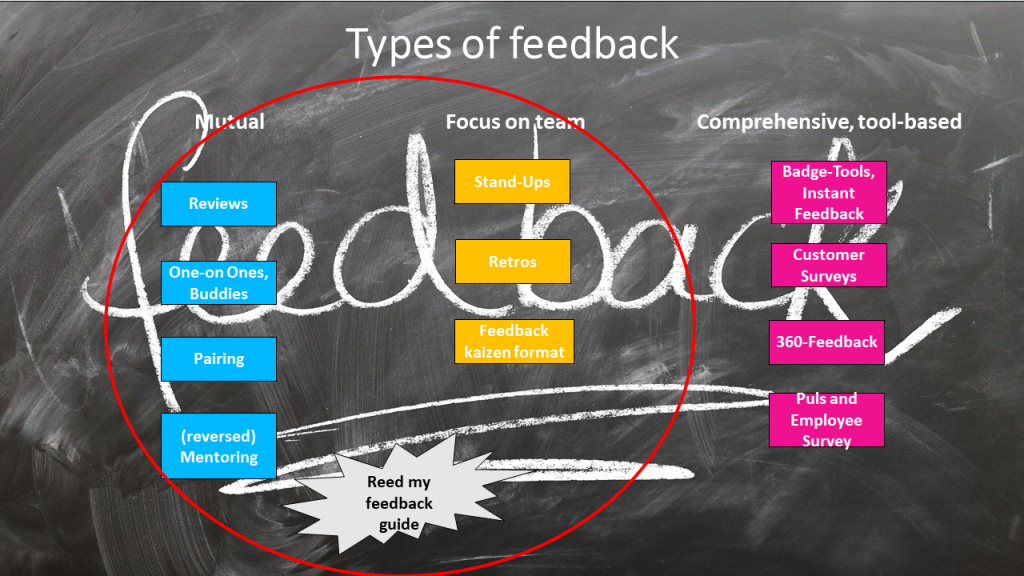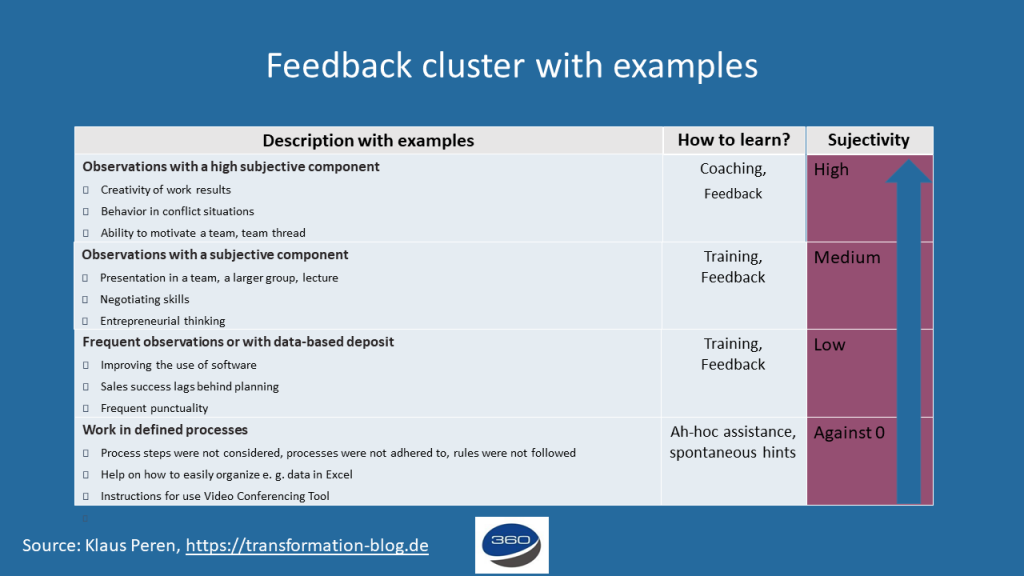In my blog you will find a very wide range of information on the subject of „feedback“:
- A systematic framework for how feedback becomes motivating and productive
https://transformation-blog.de/2021/02/24/my-framework-for-motivating-and-productive-feedback/
- My guide for feedback conversations
https://transformation-blog.de/2021/03/03/feedback-my-user-guide/ - How feedback can become an important pillar in your performance management
https://transformation-blog.de/2021/03/14/accelerate-transformation-with-agile-performance-reviews/
In this post, I answer the questions that have been asked so far in my consulting work on the topics of feedback and realignment of performance management. I would also like to draw your attention to my „Performance Management Workshop“. You can find out more via the link.
Are you missing something that should be added here? Then feel free to contact me. When I write about the necessities of companies in the following: I also mean the public service, institutions, schools etc., i.e., all areas where people work together.
1. Definition: What do I mean by feedback?
Feedback in Duden is the control of a technical, biological, or social system by feedback of the results…. For the social context, I try to explain it with my own explanation:
„A Feedback communicates a perceived or experienced behavior of a person from their own social environment. The behavior comprises the three dimensions of acting, tolerating and refraining. In the feedback, you explain what triggers this behavior in you and how you feel about it.“
2. What types of feedback are there?
Feedback can be given in different constellations. An overview is shown in the following chart. For the first two areas of personal feedback and team feedback, my feedback guide will certainly help you.

In addition, I distinguish as a rough orientation feedback according to 4 clusters, which differ in terms of sensitivity of feedback. The higher you move from bottom to top in the chart, the more subjective feedback becomes, the more it „intervenes“ in the personal sphere (and thus becomes more difficult).

3. What can constructive feedback do?
Constructive feedback helps us to identify where and how we should evolve. The image of others, the assessment of our environment towards us, differs from the image we have of ourselves. Through the constructive feedback on our own behavior, we can learn how we are seen and which – often unwanted – reactions our behavior triggers. We can learn from the advice of others and correct undes intended results of our behavior or socially unwanted behavior. In addition to personal learning, feedback is an essential driver for learning companies. As employees and managers develop, the company benefits from faster innovation, involvement, taking on responsibility and customer orientation. In addition, motivation can be increased and the bond with the company can be improved.
4. Why is feedback becoming more important?
Our lives and the world of work are becoming more fast-paced. For us, this means that we have to become more willing to change and learn. Lifelong learning is, or is becoming more and more, a reality. Everywhere and especially in the world of work, so-called soft skills are becoming more relevant. Many of them cannot or hardly can be learned through training, this requires assessments from people from the working environment, e.B. for teamwork, communication in the team, entrepreneurial thinking, proactivity, self-organization, empathy. In addition, more and more companies are dealing with the question of how they want to change the corporate culture. Feedback is also an important development tool for this. Companies are updating their performance management processes and looking for new solutions with feedback as a strong element in them.
5. How does productive and motivating feedback succeed?
The most important prerequisite for productive and motivating feedback is that the feedback provider wants to give constructive feedback and is appreciatively interested in the further development of the counterpart. Understood in this way, feedback is a well-intentioned piece of advice.
For feedback that is productive and motivating, the prerequisite or supporter is:
- Basis of trust:
For personal feedback, the prerequisite is that you trust the feedback provider. Without trust, there is little to no acceptance of personal feedback. - Openness:
Feedback should be seen as an enrichment and opportunity for personal development. - Reflectivity, change of perspective:
People who reflect their own opinions are more open to feedback. Then feedback providers see their feedback as a subjective recommendation or advice, feedback takers evaluate advice and accept good recommendations. Both put themselves in the position of the other person before the exchange, change of perspective is a success factor. - Experience, competence:
The more experience or competence a feedback provider has in the area on which feedback is given, the more likely it is to be accepted. - Support offer:
If a piece of advice is combined with the offer of support, it becomes even more valuable for the feedback taker. - Systematic approach with reversal of roles – from giving feedback to requesting feedback.
- My guide for feedback also gives you very concrete help.
6. Why is feedback difficult?
The points mentioned under 5. are already challenges for a successful exchange. In addition, feedback is a hurdle for us personally – both in taking and in giving. Findings from psychology show that feedback for us is associated with stress, sometimes even anxiety. Anxiety or stress result from the subconscious assessments of the extent to which feedback can pose a threat to one’s own status, security, or autonomy. If this is the case, the brain reacts with a „defense or flight impulse“, which we subconsciously activate. We try to escape the feedback, go into a defensive posture/argument or consider it inaccurate. Productive feedback therefore means taking into account the effect on the subconscious. Neuroscientific studies also show that this is similar for the feedback provider.
7. How to reduce the stress factor with feedback?
I have described a framework for a systematic feedback process that is less stressful in my block orf or the German HR Journal. The main elements are:
- Reversal of the feedback process: Instead of feedback, feedback is requested
- Together with predetermined topics to exchange, the uncertainty of the traditional feedback model (giving feedback, no knowledge of the topics) is limited.
- The two above-mentioned points make it possible to control and assess the feedback situation and lead to a significant reduction in stress – measured in experiments.
- Exercise of the change of perspective in advance and good preparation of the conversation.
- Role model of the top executives.
8. Why should feedback be systematic?
- The quality of feedback is also a development issue. We should therefore practice it regularly. Companies with successful feedback processes work with a cycle that provides for at least quarterly exchanges.
- For the development of soft skills, the further development of the corporate culture or the mindset in the company, a framework helps which soft skills are considered particularly important in the company.
- Competence models that follow this logic are helpful even for companies in a dynamic environment if they define the company’s long-term soft skills to be developed, which should be improved, but at the same time give sufficient freedom in the feedback process.
9. Is it possible to learn constructive feedback?
Clearly, yes. Everyone can learn constructive feedback and become better at it. These points support:
- Practicing in a systematic process.
- Advice among each other on how to become better at it.
- Mentoring for young leaders.
- A feedback guide that should be observed in the company.
- For companies that start a feedback process: buy or offer training themselves and develop internal know-how.
- Stay relaxed and make it clear that practice makes the master.
10. When should feedback be given?
Feedback on less sensitive topics should be given promptly, directly. Praise in principle also timely. For the sensitive points going into the personal sphere (the higher you act in the diagram shown above), you should take your time, prepare the conversation or, if a systematic feedback process is installed, use these appointments for this purpose.
11. Why should systematic feedback be reciprocal?
Mutual feedback should be the basis of a systematic process:
- In the practiced models of hierarchically structured companies, executives usually only receive direct feedback from their superiors. However, they have a different perspective, employees experience their superiors in other situations of everyday work. These further perspectives should not be excluded.
- In addition, companies are less and less top-down managed. Complement bottom-up elements or hierarchical structures are replaced by agile, self-controlling teams. These changes in the organization place high demands on the realignment of executives. Feedback from employees helps in these phases of change.
- Studies show that the managers who often request feedback are more successful.
- Managers who also receive feedback from their employees become more sensitive to feedback and go into these conversations better prepared.
- From a coaching perspective, this model of systematic and reciprocal feedback also encourages personal responsibility for the feedback process. By not only entering the conversation passively, adopting a wait-and-see attitude, but actively contributing and helping to shape it, the successes for the actual goal of feedback are also improved: continuous learning and getting better.
12. Should feedback be coupled with an assessment of performance?
- Performance appraisal systems are still widely used. The basic model is based on an annual top-down process, in which the employees are usually assessed once a year in different behavioral dimensions according to a kind of school grading system. Why these approaches are under criticism, I have described in this post.
- In addition, we know from the analysis of these evaluations that more than 50 percent of the deviations in the assessments between the managers come from the assessors‘ own interpretive standards – the so-called Rater effect. When a requirement is exceeded or partially not met leaves room for interpretation. Unfortunately, practice shows that the obvious recommendation to define the criteria more precisely increases the Rater effect. The same effects are shown by voting rounds for the adjustment of assessments.
- I therefore recommend that a feedback process be carried out without an assessment process. If you are looking for a logic for variable remuneration or identification of talents in the context of performance management, you will find other, better solutions.
13. Is it worth the effort?
Companies today invest a lot of time with their performance management processes. The success is often modest, the dissatisfaction of managers and employees is great. If you record the times associated with the practiced models of performance management, a time budget is quickly calculated that is larger than has to be spent on a quarterly feedback conversation.
In addition, a systematic feedback process – embedded in lean processes for goals, variable compensation and talent management – is more promising for the performance of your company and makes a significant contribution to the transformation of your company or organization.
14. How do you convince of the advantages of a systematic feedback process?
Determine the expenses for your performance management mentioned under 13., create a cost/benefit or SWOT analysis and discuss whether your existing approaches still fit the challenges for your company and whether a systematic feedback process can help you. In addition, my advice is: experiment with new approaches whose effects you are unsure. Start in a suitable area of your company with a systematic feedback process.
Before and during the start and during, measure important parameters for you such as employee satisfaction, commitment, fluctuation, productivity indicators and satisfaction with the feedback process. Smaller companies ask their employees personally about their experiences. With the first results, you can adjust the process, expand the pilot area, and redesign your performance management. Or quit the pilot if the results do not convince you.
15. Is there anything missing?
Are you still missing points? Feel free to write to me at Klaus@Transformation-Blog.de. I will then add to the FAQ.
Formularbeginn
